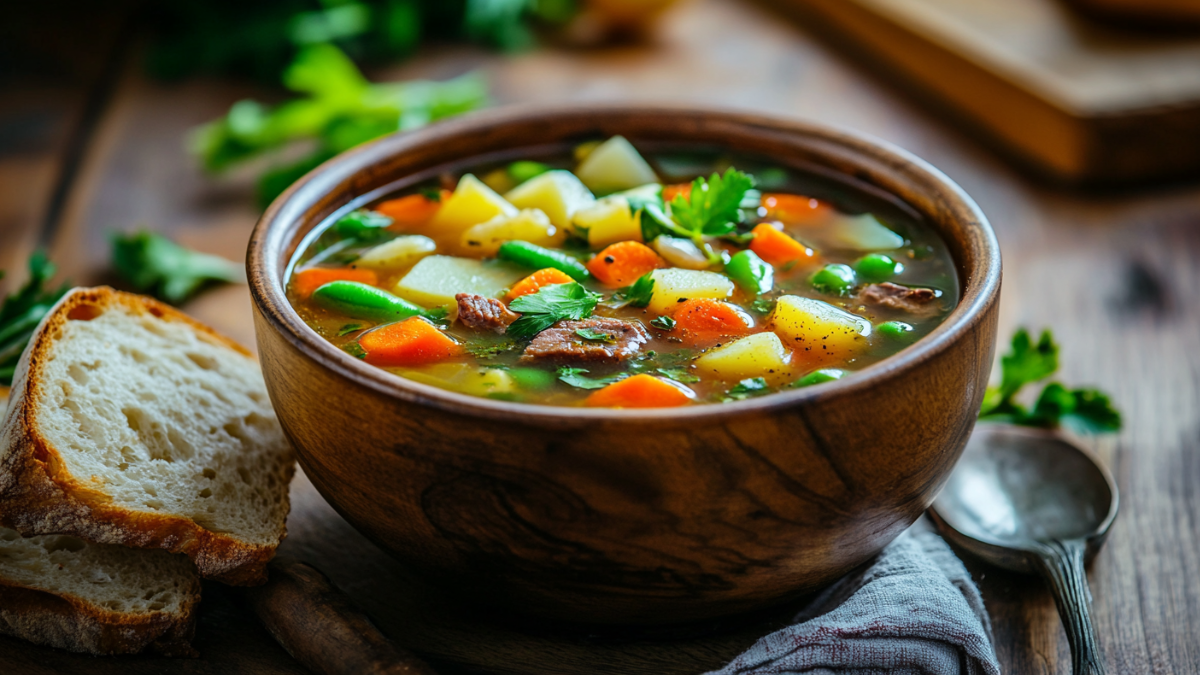Old-Fashioned Vegetable Beef Soup Recipe: A Hearty Classic
There’s nothing quite like a bowl of Old-fashioned vegetable beef soup recipe to warm your soul and nourish your body. This timeless dish has been a staple in kitchens for generations, offering a perfect blend of tender beef, fresh vegetables, and flavorful broth. Whether you’re craving comfort food on a chilly day or looking for a wholesome family dinner, this recipe delivers.
History and Origin of Vegetable Beef Soup
The roots of vegetable beef soup can be traced back to rustic home kitchens where resourcefulness turned simple ingredients into flavorful meals. Over time, the recipe has evolved, with each culture and region adding its unique twist. What remains constant is its comforting appeal, made possible by the hearty combination of beef, seasonal vegetables, and aromatic herbs.
For a similar comforting dish, explore our recipe for Beef Back Ribs Recipe, another timeless favorite packed with rich flavors.
Ingredients Overview
This classic soup brings together a variety of wholesome ingredients:
- Beef: Opt for tender cuts like chuck roast or stew meat for optimal flavor.
- Vegetables: Traditional options include carrots, celery, potatoes, green beans, tomatoes, peas, and corn.
- Broth/Base: A rich beef broth or stock creates the foundation for this soup’s depth of flavor.
- Seasonings: Add bay leaves, thyme, garlic, and parsley to elevate the taste.
For best results, prioritize fresh, high-quality ingredients. Fresh vegetables and a homemade broth can make all the difference in achieving that rich, satisfying flavor. For a gluten-free take, consider pairing this soup with our Dinner Roll Recipe Without Yeast.
The Science Behind a Flavorful Broth
A rich and flavorful broth is the backbone of any good soup, and Old-fashioned vegetable beef soup recipe is no exception. Achieving the perfect broth involves balancing key elements: aromatics, beef bones, seasonings, and simmering time.
Start with aromatics such as onions, garlic, and celery. These ingredients lay the foundation for flavor. For added depth, consider lightly sautéing them in olive oil or butter before adding liquid.
Using beef bones or a bone-in cut of meat introduces collagen, which enhances the broth’s texture, creating a velvety finish. Adding a splash of apple cider vinegar while simmering helps extract nutrients from the bones.
Seasonings are essential for elevating the broth. Common options include bay leaves, thyme, parsley, and a pinch of black pepper. Avoid adding too much salt initially, as the flavors will concentrate during cooking.
Simmer the broth for a minimum of 1.5 hours to allow all flavors to meld together. Skim off impurities periodically for a clear and clean broth.
If you want to save time, a pressure cooker can create a rich broth in under an hour. Alternatively, a slow cooker is perfect for preparing broth overnight.
By focusing on these techniques, you can ensure your soup’s broth is packed with layers of flavor that enhance every spoonful.
Selecting the Best Ingredients
To create the best version of this soup:
- Choose the Right Beef: Opt for well-marbled cuts like chuck roast for a balance of flavor and tenderness.
- Go Seasonal with Vegetables: Fresh, in-season vegetables ensure a vibrant and nutrient-packed soup.
- Use Homemade Broth: Homemade beef broth adds a depth of flavor that store-bought versions can’t match.
Step-by-Step Preparation Guide
Follow these steps for a perfect pot of vegetable beef soup:
- Prepare the Beef:
- Trim excess fat and cut the beef into bite-sized cubes.
- Sear the beef in a hot pot with a drizzle of oil to lock in flavor.
- Chop the Vegetables:
- Dice carrots, celery, and potatoes into uniform pieces for even cooking.
- Sauté Aromatics:
- In the same pot, sauté onions and garlic until fragrant.
- Combine Ingredients:
- Add the beef, vegetables, and broth to the pot.
- Stir in canned tomatoes for a tangy base.
- Simmer:
- Let the soup simmer on low heat for 1.5–2 hours to blend flavors.
For a twist, serve this soup alongside a light and refreshing Italian Pasta Salad with Lettuce.
Cooking Methods
Stovetop Method
- Perfect for a traditional approach.
- Simmer on low heat for optimal flavor infusion.
Slow Cooker Method
- Great for busy days—combine all ingredients and cook on low for 6–8 hours.
Instant Pot Method
- Saves time without compromising flavor.
- Pressure cook the beef first, then add vegetables and cook for an additional 10 minutes.
For quick meals, consider trying our Breakfast Rice Recipe for another hearty option.
Variations of the Recipe
Customize your vegetable beef soup to suit different preferences:
- Regional Variations: Add okra for a Southern twist or barley for a Midwestern flavor.
- Low-Sodium Option: Use reduced-sodium broth and season lightly with salt.
- Gluten-Free Adaptation: Ensure all ingredients, especially broths, are gluten-free.
Seasonal Variations for Vegetable Beef Soup
One of the best aspects of vegetable beef soup is its adaptability. Incorporating seasonal produce not only enhances flavor but also ensures the freshest ingredients are used.
Spring: Add tender asparagus tips, peas, and leeks for a vibrant and light flavor. These ingredients balance the richness of the beef broth while bringing a touch of sweetness.
Summer: Fresh corn kernels, zucchini, and cherry tomatoes are perfect summer additions. These ingredients give the soup a fresh and slightly sweet profile, ideal for lighter meals.
Autumn: Root vegetables like sweet potatoes, turnips, and parsnips shine in fall versions of this soup. They add an earthy sweetness and heartiness that pairs beautifully with the beef.
Winter: Deep, robust flavors dominate in winter. Add cabbage, kale, and pearl barley for a comforting and filling meal. A splash of red wine can further enhance the warmth of this seasonal version.
Adapting the soup to the season not only supports sustainable cooking practices but also ensures variety in your meals year-round.
Serving Suggestions
Enhance the experience of this hearty soup:
- Serve with crusty bread or buttermilk biscuits for dipping.
- Add a side of mixed greens with a light vinaigrette to balance the richness.
- Garnish with fresh parsley or a sprinkle of parmesan cheese for added flavor.
Perfect Side Dishes to Serve with Vegetable Beef Soup
While vegetable beef soup is a hearty dish on its own, pairing it with the right side dishes can elevate your dining experience.
Crusty Bread: The golden-brown crust and soft interior of a freshly baked loaf are perfect for soaking up the flavorful broth. Options like sourdough, French baguette, or focaccia work wonderfully.
Cornbread: The slightly sweet and crumbly texture of cornbread complements the savory richness of the soup. For a twist, try jalapeño or cheddar cornbread.
Salads: A crisp green salad with a light vinaigrette balances the richness of the soup. Incorporate ingredients like arugula, cherry tomatoes, and walnuts for added texture and flavor.
Roasted Vegetables: Simple roasted vegetables like carrots, Brussels sprouts, or squash can enhance the meal’s heartiness while adding a caramelized depth.
Cheese Platters: A small selection of cheeses, crackers, and fresh fruit can serve as a delightful accompaniment, adding variety to the meal.
By pairing your soup with these side dishes, you create a well-rounded and satisfying meal that is perfect for any occasion.
Storage and Reheating Tips
To enjoy your soup later:
- Store in airtight containers in the refrigerator for up to 4 days.
- Freeze portions for up to 3 months—thaw overnight before reheating.
- Reheat gently on the stovetop or microwave to retain texture and flavor.
Storage and Reheating Tips
Leftover Old-fashioned vegetable beef soup recipe offers endless possibilities for creating new dishes while minimizing food waste. Here are a few creative ideas:
Hearty Pot Pie: Use the soup as a filling for a pot pie. Thicken it with a cornstarch slurry or flour, then top with puff pastry or pie dough. Bake until golden and bubbling.
Beef and Vegetable Pasta Bake: Combine leftover soup with cooked pasta and a handful of shredded cheese. Bake until the top is golden for a comforting casserole.
Savory Rice Bowls: Reduce the soup to a thicker consistency by simmering it longer. Serve over steamed rice for a hearty and flavorful rice bowl.
Soup Dumplings: Strain the broth and use the vegetables and beef as a filling for dumplings or hand pies. This creates an entirely new dish with minimal effort.
Freezer-Friendly Meals: Portion the soup into individual containers and freeze for future use. It makes an excellent grab-and-go meal for busy weeknights.
These ideas not only give new life to your leftovers but also make meal planning more convenient and versatile.
Common Mistakes to Avoid
Ensure your soup turns out perfectly every time by avoiding these pitfalls:
- Overcooking Vegetables: Add them in stages to avoid mushy textures.
- Using Tough Beef Cuts: Choose cuts suitable for slow cooking to achieve tenderness.
- Underseasoning: Taste and adjust seasonings throughout the cooking process.
Pairing Beverages with Vegetable Beef Soup
Pairing the right beverage with your vegetable beef soup enhances the dining experience by complementing its rich flavors.
Red Wine: A medium-bodied red wine like Merlot or Pinot Noir pairs beautifully with the soup’s hearty beef and vegetable profile. The wine’s acidity cuts through the richness, creating a balanced flavor.
Craft Beer: Dark beers like porters or stouts complement the soup’s earthy and savory notes. For a lighter pairing, opt for amber ales or wheat beers.
Sparkling Water: If you prefer non-alcoholic options, sparkling water with a slice of lemon or lime adds a refreshing contrast to the soup’s hearty flavors.
Herbal Tea: A cup of chamomile or mint tea provides a soothing and aromatic complement, especially for a light dinner.
Apple Cider: Warm apple cider, particularly in fall or winter, pairs delightfully with the soup’s earthy tones and adds a hint of sweetness.
By carefully selecting beverages, you can further elevate your meal and create a well-rounded dining experience.
Frequently Asked Questions (FAQs)
Can I use frozen vegetables instead of fresh ones?
Yes, frozen vegetables work well and reduce prep time, but fresh vegetables offer better flavor and texture.
How do I make the soup thicker or thinner?
For a thicker soup, mash some of the cooked potatoes or add a cornstarch slurry. For a thinner consistency, add more broth.
Can I prepare this soup in advance?
Absolutely! The flavors develop even more when made a day ahead.
What are the best beef substitutes for a vegetarian version?
Replace beef with mushrooms, lentils, or plant-based protein for a hearty vegetarian option.
What pairs well with this soup?
Try serving it with cornbread, garlic toast, or a light salad.
Old-fashioned vegetable beef soup recipe remains a beloved classic, combining the warmth of tradition with the versatility to adapt to modern tastes. With this recipe, you can bring comfort and nourishment to your table, one bowl at a time.

